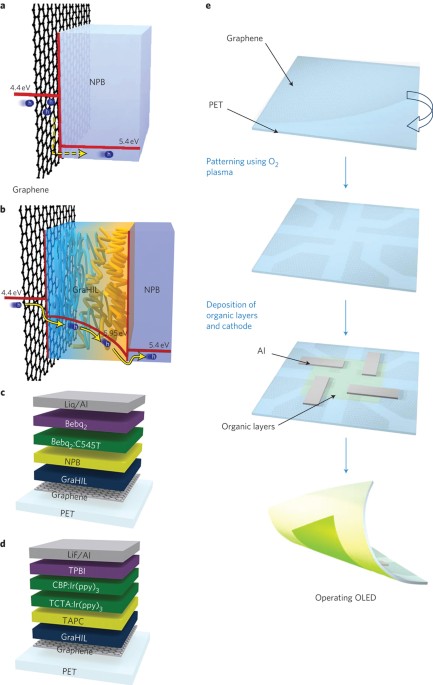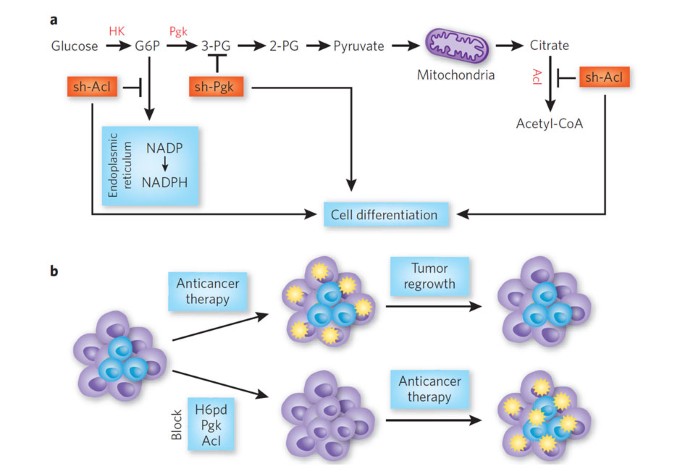
- Select a language for the TTS:
- UK English Female
- UK English Male
- US English Female
- US English Male
- Australian Female
- Australian Male
- Language selected: (auto detect) - EN
Play all audios:
ABSTRACT Although graphene films have a strong potential to replace indium tin oxide anodes in organic light-emitting diodes (OLEDs), to date, the luminous efficiency of OLEDs with graphene
anodes has been limited by a lack of efficient methods to improve the low work function and reduce the sheet resistance of graphene films to the levels required for electrodes1,2,3,4. Here,
we fabricate flexible OLEDs by modifying the graphene anode to have a high work function and low sheet resistance, and thus achieve extremely high luminous efficiencies (37.2 lm W–1 in
fluorescent OLEDs, 102.7 lm W–1 in phosphorescent OLEDs), which are significantly higher than those of optimized devices with an indium tin oxide anode (24.1 lm W–1 in fluorescent OLEDs,
85.6 lm W–1 in phosphorescent OLEDs). We also fabricate flexible white OLED lighting devices using the graphene anode. These results demonstrate the great potential of graphene anodes for
use in a wide variety of high-performance flexible organic optoelectronics. Access through your institution Buy or subscribe This is a preview of subscription content, access via your
institution ACCESS OPTIONS Access through your institution Subscribe to this journal Receive 12 print issues and online access $209.00 per year only $17.42 per issue Learn more Buy this
article * Purchase on SpringerLink * Instant access to full article PDF Buy now Prices may be subject to local taxes which are calculated during checkout ADDITIONAL ACCESS OPTIONS: * Log in
* Learn about institutional subscriptions * Read our FAQs * Contact customer support SIMILAR CONTENT BEING VIEWED BY OTHERS FLEXIBLE HIGH-PERFORMANCE GRAPHENE HYBRID PHOTODETECTORS
FUNCTIONALIZED WITH GOLD NANOSTARS AND PEROVSKITES Article Open access 18 December 2020 FLEXIBLE AND MONOLITHICALLY INTEGRATED MULTICOLOR LIGHT EMITTING DIODES USING MORPHOLOGY-CONTROLLED
GAN MICROSTRUCTURES GROWN ON GRAPHENE FILMS Article Open access 12 November 2020 FLEXIBLE PEROVSKITE LIGHT-EMITTING DIODES: RECENT PROGRESS, APPLICATIONS AND CHALLENGES Article Open access
21 April 2025 REFERENCES * Bonaccorso, F., Sun, Z., Hasan, T. & Ferrari, A. C. Graphene photonics and optoelectronics. _Nature Photon._ 4, 611–622 (2010). Article ADS Google Scholar *
Rogers, J. A. Electronic materials: making graphene for macroelectronics. _Nature Nanotech._ 3, 254–255 (2008). Article ADS Google Scholar * Wu, J. et al. Organic light-emitting diodes
on solution-processed graphene transparent electrodes. _ACS Nano_ 4, 43–48 (2010). Article Google Scholar * Sun, T. et al. Multilayered graphene used as anode of organic light emitting
devices. _Appl. Phys. Lett._ 96, 133301 (2010). Article ADS Google Scholar * Novoselov, K. S. et al. Electric field effect in atomically thin carbon films. _Science_ 306, 666–669 (2004).
Article ADS Google Scholar * Geim, A. K. & Novoselov, K. S. The rise of graphene. _Nature Mater._ 6, 183–191 (2007). Article ADS Google Scholar * Zhang, Y., Tan, Y., Stormer, H. L.
& Kim, P. Experimental observation of the quantum Hall effect and Berry's phase in graphene. _Nature_ 438, 201–205 (2005). Article ADS Google Scholar * Kim, K. S. et al.
Large-scale pattern growth of graphene films for stretchable transparent electrodes. _Nature_ 457, 706–710 (2009). Article ADS Google Scholar * Lee, Y. et al. Wafer-scale synthesis and
transfer of graphene films. _Nano. Lett._ 10, 490–493 (2010). Article ADS Google Scholar * Bae, S. et al. Roll-to-roll production of 30-inch graphene films for transparent electrodes.
_Nature Nanotech._ 5, 574–578 (2010). Article ADS Google Scholar * Li, X. et al. Large-area synthesis of high-quality and uniform graphene films on copper foils. _Science_ 324, 1312–1314
(2009). Article ADS Google Scholar * Reina, A. et al. Layer area, few-layer graphene films on arbitrary substrates by chemical vapor deposition. _Nano Lett._ 9, 30–35 (2009). Article ADS
Google Scholar * Eda, G., Fanchini, G. & Chhowalla, M. Large-area ultrathin films of reduced graphene oxide as a transparent and flexible electronic material. _Nature Nanotech._ 3,
270–274 (2008). Article Google Scholar * Matyba, P. et al. Graphene and mobile ions: the key to all-plastic, solution-processed light-emitting devices. _ACS Nano_ 4, 637–642 (2010).
Article Google Scholar * Arco, L. G. D. et al. Continuous, highly flexible, and transparent graphene films by chemical vapor deposition for organic photovoltaics. _ACS Nano_ 4, 2865–2873
(2010). Article Google Scholar * Yin, Z. et al. Organic photovoltaic devices using highly flexible reduced graphene oxide films as transparent electrodes. _ACS Nano_ 4, 5263–5268 (2010).
Article Google Scholar * Wu, J. et al. Organic solar cells with solution-processed graphene transparent electrodes. _Appl. Phys. Lett._ 92, 263302 (2008). Article ADS Google Scholar *
Choe, M. et al. Efficient bulk-heterojunction photovoltaic cells with transparent multi-layer graphene electrodes. _Org. Electron._ 11, 1864–1869 (2010). Article Google Scholar * Wang, X.,
Zhi, L. & Müllen, K. Transparent, conductive graphene electrodes for dye-sensitized solar cells. _Nano Lett._ 8, 323–327 (2008). Article ADS Google Scholar * Kumar, A. & Zhou, C.
The race to replace tin-doped indium oxide: which material will win? _ACS Nano_ 4, 11–14 (2010). Article Google Scholar * Choi, M-R. et al. Soluble self-doped conducting polymer
compositions with tunable work function as hole injection/extraction layers in organic optoelectronics. _Angew. Chem. Int. Ed._ 50, 6274–6277 (2011). Article Google Scholar * Li, J. et al.
Organic light-emitting diodes having carbon nanotube anodes. _Nano Lett._ 6, 2472–2477 (2006). Article ADS Google Scholar * Chien, Y-M., Lefevre, F., Shin, I. & Izquierdo, R. A
solution processed top emission OLED with transparent carbon nanotube electrodes. _Nanotechnology_ 21, 134020 (2010). Article ADS Google Scholar * Helender, M. G. et al. Chlorinated
indium tin oxide electrodes with high work function for organic device compatibility. _Science_ 332, 944–947 (2011). Article ADS Google Scholar * Poplavskyy, D., Su, W. & So, F.
Bipolar charge transport, injection, and trapping studies in a model green-emitting polyfluorene copolymer. _J. Appl. Phys._ 98, 014501 (2005). Article ADS Google Scholar * Campbell, A.
J., Bradley, D. D. C. & Antoniadisc, H. Quantifying the efficiency of electrodes for positive carrier injection into poly(9,9-dioctylfluorene) and representative copolymers. _J. Appl.
Phys._ 89, 3343–3351 (2001). Article ADS Google Scholar * Cheung, C. H., Kwok, K. C., Tse, S. C. & So, S. K. Determination of carrier mobility in phenylamine by time-of-flight,
dark-injection, and thin film transistor techniques. _J. Appl. Phys._ 103, 093705 (2008). Article ADS Google Scholar * Harding, M. J., Poplavskyy, D., Choong, V-E., So, F. & Campbell,
A. J. Variations in hole injection due to fast and slow interfacial traps in polymer light-emitting diodes with interlayers. _Adv. Funct. Mater._ 20, 119–130 (2010). Article Google Scholar
* Jong, M. P. D., IJzendoorn, L. J. V. & Voigt, M. J. A. D. Stability of the interface between indium-tin-oxide and poly (3,4-ethylenedioxythiophene)/poly(styrenesulfonate) in polymer
light-emitting diodes. _Appl. Phys. Lett._ 77, 2255–2257 (2000). Article ADS Google Scholar * Sekitani, T. et al. Stretchable active-matrix organic light-emitting diode display using
printable elastic conductors. _Nature Mater._ 8, 494–499 (2009). Article ADS Google Scholar Download references ACKNOWLEDGEMENTS This research was supported by the Basic Research Program
and Global Frontier Research Center for Advanced Soft Electronics through the National Research Foundation of Korea (NRF), funded by the Ministry of Education, Science and Technology (nos.
2009-0067533, 2009-0075025, 2011-0006268 and 2009-0090177). This research was also supported by the Converging Research Center Program through the Ministry of Education, Science and
Technology (no. 2010K001431). AUTHOR INFORMATION AUTHORS AND AFFILIATIONS * Department of Materials Science and Engineering, Pohang University of Science and Technology (POSTECH), Pohang,
790-784, Gyungbuk, Republic of Korea Tae-Hee Han, Mi-Ri Choi, Seong-Hoon Woo & Tae-Woo Lee * SKKU Advanced Institute of Nanotechnology (SAINT), Center for Human Interface Nano Technology
(HINT) and School of Advanced Materials Science and Engineering, Sungkyunkwan University, Suwon, 440-746, Gyeonggi-do, Republic of Korea Youngbin Lee, Sang-Hoon Bae & Jong-Hyun Ahn *
Department of Chemistry, Seoul National University, Seoul, 151-747, Republic of Korea Byung Hee Hong Authors * Tae-Hee Han View author publications You can also search for this author
inPubMed Google Scholar * Youngbin Lee View author publications You can also search for this author inPubMed Google Scholar * Mi-Ri Choi View author publications You can also search for this
author inPubMed Google Scholar * Seong-Hoon Woo View author publications You can also search for this author inPubMed Google Scholar * Sang-Hoon Bae View author publications You can also
search for this author inPubMed Google Scholar * Byung Hee Hong View author publications You can also search for this author inPubMed Google Scholar * Jong-Hyun Ahn View author publications
You can also search for this author inPubMed Google Scholar * Tae-Woo Lee View author publications You can also search for this author inPubMed Google Scholar CONTRIBUTIONS T.-H.H. designed
and conducted most of the experiments, analysed the data and prepared the manuscript. Y.L. and S.-H.B. conducted experiments regarding graphene growth, patterning of graphene anodes and
characterization. S.-H.W. and M.-R.C. helped with the OLED fabrication experiments. B.H.H. interpreted data and suggested improvements to the manuscript. J.-H.A. designed the graphene
experiments, analysed data and prepared the manuscript. T.-W.L. initiated the study, designed all the experiments, analysed the data and prepared the manuscript. All authors discussed the
results and contributed to the paper. CORRESPONDING AUTHORS Correspondence to Jong-Hyun Ahn or Tae-Woo Lee. ETHICS DECLARATIONS COMPETING INTERESTS The authors declare no competing financial
interests. SUPPLEMENTARY INFORMATION SUPPLEMENTARY INFORMATION Supplementary information (PDF 2635 kb) RIGHTS AND PERMISSIONS Reprints and permissions ABOUT THIS ARTICLE CITE THIS ARTICLE
Han, TH., Lee, Y., Choi, MR. _et al._ Extremely efficient flexible organic light-emitting diodes with modified graphene anode. _Nature Photon_ 6, 105–110 (2012).
https://doi.org/10.1038/nphoton.2011.318 Download citation * Received: 11 July 2011 * Accepted: 08 November 2011 * Published: 10 January 2012 * Issue Date: February 2012 * DOI:
https://doi.org/10.1038/nphoton.2011.318 SHARE THIS ARTICLE Anyone you share the following link with will be able to read this content: Get shareable link Sorry, a shareable link is not
currently available for this article. Copy to clipboard Provided by the Springer Nature SharedIt content-sharing initiative







